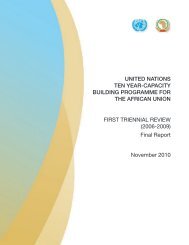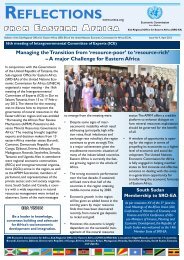Tool kit for Gender and Agriculture - Economic Commission for Africa
Tool kit for Gender and Agriculture - Economic Commission for Africa
Tool kit for Gender and Agriculture - Economic Commission for Africa
Create successful ePaper yourself
Turn your PDF publications into a flip-book with our unique Google optimized e-Paper software.
42<br />
Improving <strong>Agriculture</strong> through <strong>Gender</strong> Analysis<br />
project by men <strong>and</strong> women participating in the project<br />
• Average number, type, <strong>and</strong> distribution of animals owned by men <strong>and</strong> women participating<br />
in the project<br />
• Average <strong>and</strong> distribution of revenue from processing animal products by women<br />
targeted by the project<br />
• Views of men <strong>and</strong> women participants on the impact of project components on<br />
their <strong>and</strong> their families’ revenue <strong>and</strong> well-being<br />
• Percentage, specific posts, <strong>and</strong> specializations held by women in the ministry or<br />
other agency, by grade.<br />
• Percentage of women recruited or trained by the ministry or project, by grade.<br />
F. Policy-Based Lending<br />
Policy-based Bank lending in agriculture usually takes the <strong>for</strong>m of sectoral adjustment<br />
programs. Initially such policies were believed to be unaffected by gender; however, it<br />
is now recognized that rigidities in the agricultural production structure can include<br />
gender-based constraints to increased productivity. This is because of gender-based<br />
differences in access to in<strong>for</strong>mation, transaction costs of changing production functions,<br />
the resource base, <strong>and</strong> the capital stock of individual farmers. Greater attention<br />
to gender in policy-related lending <strong>for</strong> agriculture may, there<strong>for</strong>e, be needed to ensure<br />
an improved supply response by women farmers, overcome built-in production constraints,<br />
<strong>and</strong> protect vulnerable groups such as poor women. Ways of incorporating<br />
gender concerns in policy-based agriculture lending are dealt with in Chapter III.







